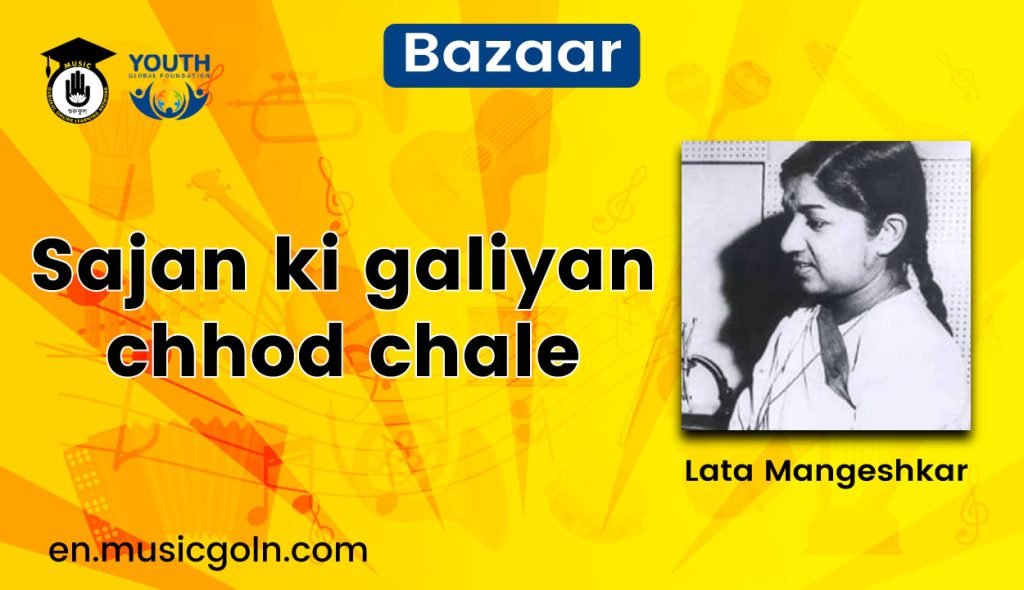Sajan ki galiyan chhod chale lyrics | Lata Mangeshkar | Bazaar | 1949
Movie: Bazaar
Singers: Lata Mangeshkar
Song Lyricists: Qamar Jalalabadi
Music Composer: Shyam Sunder Premi
Music Director: Shyam Sunder Premi
Bazaar is an Indian Hindi language family-drama film of year 1949. The film is directed by K. Amarnath and produced under the banner Madhukar Pictures. The story was written by K. Amarnath, while the dialogue and lyrics were by Qamar Jalalabadi, with music by Shyam Sunder.
Sajan ki galiyan chhod chale lyrics | Lata Mangeshkar | Bazaar | 1949
Sajan ki galiyan chhod chale lyrics :
Saajan ki galiyan
Chhod chale
Dil roya aansoo
Bahe na sake
Yeh jina bhi
Koi jina hai
Hum unko apna
Kahe na sake
Saajan ki galiyan
Jab unse bichhad
Kar aane lage
Jab unse bichhad
Kar aane lage
Ruk ruk ke chale
Chal chal ke ruke
Lab kanpe aankhen
Bhar aayi
Kuch kehna chaha
Kahe na sake
Saajan ki galiyan
Chhod chale
Dil roya aansoo
Bahe na sake
Saajan ki galiyan
Unke liye unko
Chhod diya
Khud apne dil
Ko tod diya
Hum unke dil
Mein rehte the
Unke qadamon
Mein rahe na sake
Saajan ki galiyan
Chhod chale
Dil roya aansoo
Beh na sake
Saajan ki galiyan
Saajan hai waha aur
Hum hai yaha
Aise dil ko le jaye kaha
Jo paas bhi unke
Rahe na sake
Aur dard e judaai
Sahe na sake
Saajan ki galiyan
Chhod chale
Dil roya aansoo
Bahe na sake
Saajan ki galiyan.
Lata Mangeshkar (born as Hema Mangeshkar; 28 September 1929 – 6 February 2022)was an Indian playback singer and occasional music composer. She is widely considered to have been one of the greatest and most influential singers in India.Her contribution to the Indian music industry in a career spanning eight decades gained her honorific titles such as the “Queen of Melody”, “Nightingale of India”, and “Voice of the Millennium”.
Lata recorded songs in over thirty-six Indian languages and a few foreign languages, though primarily in Marathi, Hindi, and Bengali. Her foreign languages included English, Russian, Dutch, Nepali, and Swahili.She received several accolades and honors throughout her career. In 1989, the Dadasaheb Phalke Award was bestowed on her by the Government of India.
In 2001, in recognition of her contributions to the nation, she was awarded the Bharat Ratna, India’s highest civilian honour; she is only the second female singer, after M. S. Subbulakshmi, to receive this honour. France conferred on her its highest civilian award, Officer of the National Order of the Legion of Honour, in 2007.
She was the recipient of three National Film Awards, 15 Bengal Film Journalists’ Association Awards, four Filmfare Best Female Playback Awards, two Filmfare Special Awards, the Filmfare Lifetime Achievement Award and many more. In 1974, she was one of the first Indian playback singers to perform at the Royal Albert Hall in London, UK. Her last recorded song was “Saugandh Mujhe Is Mitti ki” released on 30 March 2019 as a tribute to the Indian Army and the Nation.
At one point, she appeared in the Guinness World Records, which listed her as the most recorded artist in history between 1948 and 1987.
Initially, she is said to have imitated the acclaimed singer Noor Jehan, but she later developed her own style of singing.She brought a new signature style of singing to Indian film music, moving away from mehfil-style performances to suit both ‘modern’ and ‘traditional’ female protagonists. A soprano range voice with less volume or amplitude, she had enough weight in her voice to give definite shape to the melody of Indian film songs.
Although she had limited coloratura skills in her early career, she developed better tone and pitch as she progressed in her playback career. Lyrics of songs in Hindi movies were, in those days, primarily composed by Urdu poets and contained a higher proportion of Urdu words, including the dialogue.
Actor Dilip Kumar once made a mildly disapproving remark about her accent while singing Hindi/Urdu songs; so for a period of time, she took lessons in Urdu from an Urdu teacher named Shafi.In subsequent interviews she said that Noor Jehan heard her as a child and had told her to practice a lot. The two stayed in touch with each other for many years to come
In 2001, Mangeshkar was awarded the Bharat Ratna, India’s highest civilian honour.
In the same year, she established the Master Deenanath Mangeshkar Hospital in Pune, managed by the Medical Foundation (founded by the Mangeshkar family in October 1989). In 2005, she designed a jewellery collection called Swaranjali, which was crafted by Adora, an Indian diamond export company. Five pieces from the collection raised £105,000 at a Christie’s auction, and a part of the money was donated for the 2005 Kashmir earthquake relief. Also in 2001, she recorded her first Hindi song with the composer Ilaiyaraaja, for the film Lajja;
she had earlier recorded Tamil and Telugu songs composed by Ilaiyaraaja.
Her song “Wada Na Tod” was included in the film Eternal Sunshine of the Spotless Mind (2004) and in its soundtrack.
Read more:
- Darna mohabbat lyrics | Lata Mangeshkar, Shamshad Begum | Andaz | 1949
- Tod diya dil mera lyrics | Lata Mangeshkar | Andaz | 1949
- Uthaye ja unke sitam lyrics | Lata Mangeshkar | Andaz | 1949
- Koi mere dil men lyrics | Lata Mangeshkar | Andaz | 1949
- Meri ladli re lyrics | Chorus, Lata Mangeshkar | Andaz | 1949
